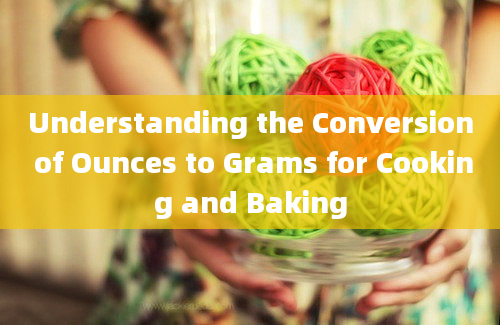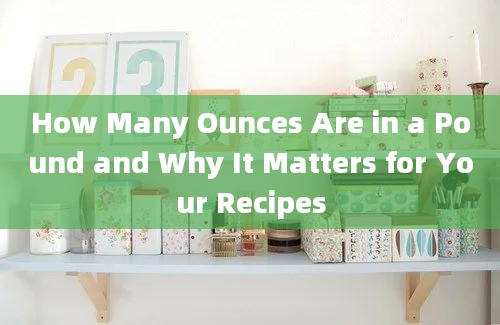Understanding the Conversion of Ounces to Grams for Cooking and Baking

Accurate measurements are crucial in cooking and baking to ensure the desired outcome of recipes. One common challenge faced by chefs and home cooks alike is the conversion between different units of measurement, particularly between ounces and grams. This article delves into the importance of understanding this conversion, provides a detailed guide on how to convert ounces to grams, and explores why precision matters in culinary arts.
Why Conversion Matters
Cooking and baking are sciences where precise measurements can make the difference between a perfect dish and a culinary disaster. According to the [Institute of Culinary Education (ICE)](https://www.ice.edu/), accurate measurements are essential for consistency and quality in recipes. Ounces and grams are two of the most commonly used units of measurement, with ounces being prevalent in the United States and grams being the standard in most other parts of the world.
The Basics of Conversion
1. Understanding the Units:
Ounce (oz): An ounce is a unit of mass used primarily in the United States. It is commonly used to measure both liquid and dry ingredients.
Gram (g): A gram is a unit of mass in the metric system, widely used internationally. It provides a more precise measurement due to its smaller unit size.
2. Conversion Formula:
To convert ounces to grams, you can use the formula:
\[
\text{Grams} = \text{Ounces} \times 28.3495
\]
This conversion factor is derived from the fact that 1 ounce is approximately equal to 28.3495 grams.
Practical Examples
Let's consider some practical examples to illustrate the conversion:
Example 1: Converting 4 ounces to grams:
\[
4 \text{ oz} \times 28.3495 = 113.398 \text{ g}
\]
Example 2: Converting 8 ounces (which is equivalent to 1 cup of flour in many recipes) to grams:
\[
8 \text{ oz} \times 28.3495 = 226.796 \text{ g}
\]
Tools for Accurate Conversion
While manual calculations are useful, kitchen scales are indispensable for accurate measurements. According to [Cook's Illustrated](https://www.cooksillustrated.com/), using a digital kitchen scale can significantly improve the precision of your ingredient measurements.
Importance in Baking
Baking is particularly sensitive to measurement accuracy. Ingredients like flour, sugar, and butter need to be measured precisely to achieve the right texture and flavor. For instance, the [King Arthur Baking Company](https://www.kingarthurbaking.com/) emphasizes that even small deviations in measurements can lead to significant differences in the final product.
Conclusion
Understanding the conversion of ounces to grams is a fundamental skill in cooking and baking. It ensures consistency, accuracy, and ultimately, the success of your culinary endeavors. Whether you rely on manual calculations or digital tools, mastering this conversion will elevate your cooking and baking skills.
Frequently Asked Questions (FAQs)
Q1: Why is it important to convert ounces to grams in cooking and baking?
A1: Converting ounces to grams ensures precision in measurements, which is crucial for consistent and highquality results in cooking and baking. Different regions use different measurement systems, and accurate conversions help in following recipes correctly.
Q2: What is the conversion factor from ounces to grams?
A2: The conversion factor from ounces to grams is approximately 28.3495. This means 1 ounce is equal to 28.3495 grams.
Q3: How do I convert 2 ounces to grams?
A3: To convert 2 ounces to grams, use the formula:
\[
2 \text{ oz} \times 28.3495 = 56.699 \text{ g}
\]
Q4: Can I use a kitchen scale for ounce to gram conversion?
A4: Yes, a digital kitchen scale is an excellent tool for accurate ounce to gram conversion. Most kitchen scales have a toggle feature to switch between these units, making it convenient for precise measurements.
Q5: Why is precision more critical in baking than in cooking?
A5: Precision is more critical in baking because it is a science where the chemical reactions between ingredients need to be exact. Even small deviations can affect the texture, rise, and flavor of baked goods.
Q6: How many grams are in a cup of flour if it weighs 8 ounces?
A6: An 8ounce cup of flour is approximately 226.796 grams, calculated as:
\[
8 \text{ oz} \times 28.3495 = 226.796 \text{ g}
\]
Q7: What are some common ingredients measured in ounces and grams?
A7: Common ingredients measured in ounces and grams include flour, sugar, butter, chocolate, and various spices. These ingredients are fundamental in both cooking and baking.
Q8: Is it better to measure by weight or volume in baking?
A8: Measuring by weight is generally better in baking because it is more accurate. Volume measurements can vary due to factors like how tightly ingredients are packed, whereas weight measurements are consistent.
Q9: How can I ensure accurate measurements when converting ounces to grams?
A9: To ensure accurate measurements, use a reliable digital kitchen scale and follow the conversion formula precisely. Doublecheck your calculations and use standardized measuring cups and spoons for volume measurements.
Q10: What resources can help me with ounce to gram conversions?
A10: Resources like culinary textbooks, reputable cooking websites (such as [Allrecipes](https://www.allrecipes.com/) and [Serious Eats](https://www.seriouseats.com/)), and mobile apps designed for kitchen conversions can provide helpful guidance and tools for accurate ounce to gram conversions.










